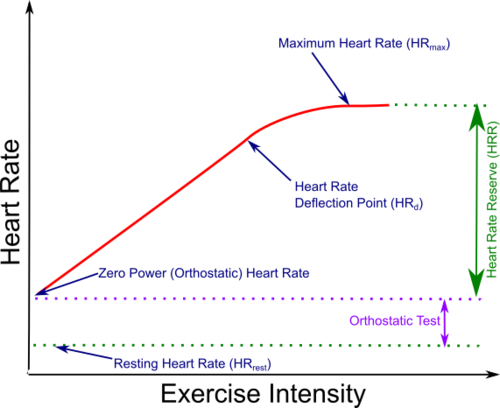Difference between revisions of "Heart Rate Reserve"
From Fellrnr.com, Running tips
User:Fellrnr (User talk:Fellrnr | contribs) m (→See Also) |
User:Fellrnr (User talk:Fellrnr | contribs) m |
||
| Line 1: | Line 1: | ||
[[File:HeartRateSimplified.png|right|thumb|500px|A simplified chart of heart rate against exercise intensity showing [[Maximum Heart Rate]], [[Heart Rate Reserve]], [[Resting Heart Rate]] and [[Heart Rate Deflection]].]] | [[File:HeartRateSimplified.png|right|thumb|500px|A simplified chart of heart rate against exercise intensity showing [[Maximum Heart Rate]], [[Heart Rate Reserve]], [[Resting Heart Rate]] and [[Heart Rate Deflection]].]] | ||
| − | Heart Rate Reserve (HRR) is the difference between your [[Maximum Heart Rate]] (HR<sub>max</sub>) and [[Resting Heart Rate]] (HR<sub>rest</sub>). Exercise intensity can be evaluated by comparing your heart rate as a percentage of HRR. | + | [[Heart Rate]] Reserve (HRR) is the difference between your [[Maximum Heart Rate]] (HR<sub>max</sub>) and [[Resting Heart Rate]] (HR<sub>rest</sub>). Exercise intensity can be evaluated by comparing your heart rate as a percentage of HRR. |
=Calculating Heart Rate Reserve= | =Calculating Heart Rate Reserve= | ||
| − | The calculation to work out %HRR is (HR<sub>ex</sub> – HR<sub>rest</sub>)/(HR<sub>max</sub> – HR<sub>rest</sub>), where HR<sub>ex</sub> is the exercise Heart Rate. For example a HR<sub>max</sub> of 180, a HR<sub>rest</sub> of 40 and HR<sub>ex</sub> of 140 would be (140 – 40)/(180 – 40), which is 71%. | + | The calculation to work out %HRR is (HR<sub>ex</sub> – HR<sub>rest</sub>)/(HR<sub>max</sub> – HR<sub>rest</sub>), where HR<sub>ex</sub> is the exercise [[Heart Rate]]. For example a HR<sub>max</sub> of 180, a HR<sub>rest</sub> of 40 and HR<sub>ex</sub> of 140 would be (140 – 40)/(180 – 40), which is 71%. |
=Why %HRR rather than %HR<sub>max</sub>= | =Why %HRR rather than %HR<sub>max</sub>= | ||
Using %HRR is better than a percentage of HR<sub>max</sub>. as it reflects the relative intensity more accurately. For example, if two athletes both have a HR<sub>max</sub> of 180, but one has a HR<sub>rest</sub> of 40 and the other 70, at HR<sub>ex</sub> of 140would be same %HR<sub>max</sub>, but one is at 64 %HRR and the other is at 71 %HRR. | Using %HRR is better than a percentage of HR<sub>max</sub>. as it reflects the relative intensity more accurately. For example, if two athletes both have a HR<sub>max</sub> of 180, but one has a HR<sub>rest</sub> of 40 and the other 70, at HR<sub>ex</sub> of 140would be same %HR<sub>max</sub>, but one is at 64 %HRR and the other is at 71 %HRR. | ||
Revision as of 19:23, 9 April 2012

A simplified chart of heart rate against exercise intensity showing Maximum Heart Rate, Heart Rate Reserve, Resting Heart Rate and Heart Rate Deflection.
Heart Rate Reserve (HRR) is the difference between your Maximum Heart Rate (HRmax) and Resting Heart Rate (HRrest). Exercise intensity can be evaluated by comparing your heart rate as a percentage of HRR.
1 Calculating Heart Rate Reserve
The calculation to work out %HRR is (HRex – HRrest)/(HRmax – HRrest), where HRex is the exercise Heart Rate. For example a HRmax of 180, a HRrest of 40 and HRex of 140 would be (140 – 40)/(180 – 40), which is 71%.
2 Why %HRR rather than %HRmax
Using %HRR is better than a percentage of HRmax. as it reflects the relative intensity more accurately. For example, if two athletes both have a HRmax of 180, but one has a HRrest of 40 and the other 70, at HRex of 140would be same %HRmax, but one is at 64 %HRR and the other is at 71 %HRR.